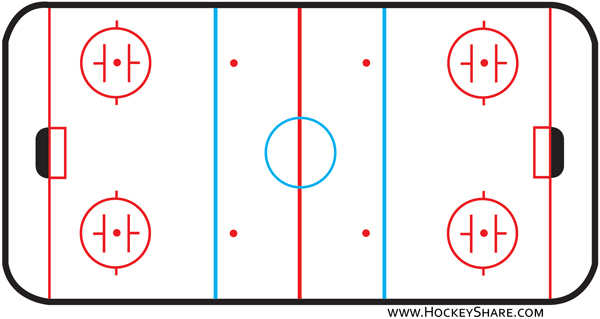Understanding the layout of a hockey rink is crucial for players and fans. A hockey rink diagram helps visualize key areas and markings.
Hockey is a fast-paced sport requiring precise movements and strategies. The rink’s design plays a significant role in gameplay. Knowing the rink’s layout can enhance your appreciation and understanding of the game. From face-off circles to penalty boxes, each section serves a unique purpose.
This blog post will break down the components of a hockey rink diagram. Whether you’re a new fan or a seasoned player, knowing the rink’s layout can improve your game experience. Dive into the details and discover what makes this sport so thrilling.

Credit: www.usahockey.com
Rink Dimensions
Understanding the dimensions of a hockey rink is crucial for players, coaches, and fans alike. Whether you’re learning the game, planning to build a rink, or just curious, knowing the exact measurements can enhance your appreciation of the sport. Let’s dive into the specifics of the rink dimensions.
Length And Width
The standard size of a hockey rink is 200 feet long and 85 feet wide. This is the regulation size used in the NHL and most professional leagues around the world. However, in Europe, the rinks are typically slightly larger, measuring 197 feet by 98.5 feet.
These dimensions can affect the style of play. A wider rink, like those in Europe, allows for more skating room and can lead to a more fluid game. On the other hand, the standard NHL size promotes a faster, more physical style of play.
Have you ever skated on both types of rinks? Which did you prefer?
Zones And Lines
A hockey rink is divided into three main zones: the defensive zone, the neutral zone, and the offensive zone. These zones are created by two blue lines, which are 75 feet apart. The center red line divides the rink into two halves.
In each zone, there are faceoff circles and dots. The defensive and offensive zones each contain two faceoff circles, while the neutral zone has one at center ice. The lines and zones are critical for understanding the rules and strategies of the game.
Do you find it easier to follow a game when you understand the layout of the rink?
Next time you’re watching or playing, pay attention to how the zones and lines influence the flow of the game. It might give you a new perspective on the action!
Faceoff Circles
Faceoff circles are key parts of a hockey rink diagram. They mark where players line up for faceoffs. These circles help keep the game organized and fair.
Faceoff circles play a crucial role in hockey games. They are the spots where play restarts after stoppages. Understanding these circles can help you appreciate the game better.Center Ice Circle
The center ice circle is located at the middle of the rink. This is where the game starts and where play resumes after each goal. Players line up here to battle for control of the puck. Winning the faceoff can give your team an early advantage. I remember watching my first live hockey game and seeing the intensity in the players’ eyes during the faceoff. It was thrilling!Neutral Zone Circles
The neutral zone circles are positioned between the blue lines and the center ice circle. These circles are used when play needs to restart in the neutral zone. During faceoffs here, teams often use specific strategies to gain control. The puck can quickly move to either side, making these faceoffs unpredictable. Have you ever noticed how teams adjust their positioning depending on the location of the faceoff? It’s fascinating to see the tactical adjustments in real time. Faceoff circles are more than just markings on the ice. They are strategic points where games can be won or lost. Next time you watch a game, pay attention to the faceoff circles and the battles that unfold there. It might just change the way you see the game.Goal Crease
Goal Crease is a key area in the hockey rink diagram. It marks the space where goals are scored. Understanding this helps players and fans better follow the game.
The goal crease is an essential part of the hockey rink diagram. It’s where the magic happens, the place every goalie fiercely defends, and every forward dreams of scoring. Understanding the goal crease’s specifics can elevate your appreciation of the game and even improve your playing strategy.Shape And Size
The goal crease is a semi-circular area located directly in front of the goal. It extends six feet from the goal line and is marked with a blue line. This distinct shape ensures that everyone knows the critical area where goalkeepers can operate freely.Purpose And Rules
The primary purpose of the goal crease is to protect the goalie. Only the goalie can stay in this area without restrictions, making it their safe zone. However, players can enter the crease if they don’t interfere with the goalie. If they do, the goal can be disallowed. Have you ever seen a goal disallowed because a player interfered with the goalie? It’s a frustrating moment for the team but shows how crucial the crease rules are. Understanding these rules can help you avoid penalties and score legitimate goals. Next time you’re on the ice, remember the goal crease’s boundaries and respect them. This knowledge can make the difference between a winning goal and a costly mistake.Blue Lines
Blue lines on a hockey rink diagram mark the zones. They help in understanding player positions and game rules.
The blue lines on a hockey rink are essential for the game’s flow and structure. They split the rink into three zones: defensive, neutral, and offensive. Understanding these lines is crucial for grasping important rules like offsides.Placement
The blue lines are located 25 feet from the center red line. They are 12 inches wide. These lines divide the rink into three equal parts. The placement of the blue lines is vital for game strategy. It helps players know when they are in scoring position. This can make or break a game. When I first started playing hockey, I was always confused about the blue lines. But after a few games, I saw how they impact the strategy. It was like a light bulb moment for me.Offside Rule
The offside rule is one of the most important rules in hockey. If a player crosses the opponent’s blue line before the puck, it’s offside. This stops players from cherry-picking near the opponent’s goal. Understanding offsides can change how you watch the game. You start to see why players pass the puck back before attacking. It keeps the game fair and competitive. Imagine your team is about to score, but the ref calls offside. It’s frustrating, but it’s part of the game. Knowing the rule helps you appreciate the skill involved. Why do you think the offside rule is so crucial in hockey? Does it make the game more exciting or just more complicated? Share your thoughts in the comments. By grasping the placement of blue lines and the offside rule, you can better understand the strategy and flow of hockey. It’s not just about skating fast; it’s about playing smart.Red Line
The red line on a hockey rink is essential for the game. It divides the rink into two equal halves. It stretches from one side of the rink to the other. This line helps the referee make crucial decisions. It also influences how players move and play.
Center Line Role
The red line is often called the center line. It plays a key role in face-offs. Face-offs occur at the start of the game and after goals. Players line up on either side of the red line. The referee drops the puck at the center dot.
The red line also helps in determining offside. Players must cross the red line before entering the attacking zone. This rule keeps the game fair and organized.
Icing Rule
The red line is crucial for the icing rule. Icing occurs when a player shoots the puck across both the center line and the goal line. This happens without the puck touching another player. Icing stops play and results in a face-off in the offending team’s zone.
The icing rule prevents teams from simply dumping the puck out of their zone. It encourages skillful passing and puck control. Understanding the red line and icing rule is vital for any hockey player.
Bench Areas
The bench areas on a hockey rink diagram are where players and coaches sit during a game. These zones are located along the sides of the rink, near the center line. They provide quick access to the ice for substitutions.
When discussing the hockey rink diagram, it’s essential to understand the bench areas. These areas are crucial for team strategy and player management. The bench areas typically include the player bench and the penalty box. Each serves a specific purpose that can significantly impact the flow of the game.Player Bench
The player bench is where the magic happens. This is where players sit when they are not on the ice. Coaches use this area to communicate strategies and make quick changes during the game. On a personal note, I remember my first hockey game where the coach’s instructions from the bench were pivotal. His quick decisions and motivating words kept the team energized. The bench is also where you can see the raw emotions of the game. Players cheer, strategize, and sometimes even argue. It’s an intense area that embodies the spirit of teamwork and competition.Penalty Box
The penalty box is a unique area on the rink. This is where players go when they have committed a foul. It’s often referred to as the “sin bin.” Spending time in the penalty box can be frustrating. I once spent two minutes in the box for a minor infraction and it felt like an eternity. It not only affects the player but can put the entire team at a disadvantage. When a player is in the penalty box, the team plays with one less player. This can create opportunities for the opposing team. It’s a high-stakes situation that can change the momentum of the game. Understanding these bench areas can give you a deeper appreciation of the game’s dynamics. How do you think the player bench and penalty box influence the strategies used by teams?Corners
Corners in a hockey rink diagram mark crucial zones for players. These areas often see intense action and strategic maneuvers. Proper understanding aids in game strategy and player positioning.
The corners of a hockey rink are often the most dynamic areas of the ice. Whether you’re a player or a coach, understanding the importance of corners can elevate your game. Let’s dive into why corners matter and how you can use them to your advantage. ###Function
Corners serve as key areas for controlling the puck. When the puck is in the corner, it’s harder for the opposing team to gain possession. Players can use the boards to shield the puck and make strategic passes. The confined space forces quick decision-making, enhancing your skills under pressure. Moreover, corners are where many offensive plays start. Winning battles in the corners can lead to scoring opportunities. ###Play Strategies
Using the corners effectively can change the momentum of the game. One strategy is the cycle play. By passing the puck along the boards and moving in a circular motion, you can tire out defenders. This creates openings for shots on goal. Another tactic is aggressive forechecking. Pressure the opponent in the corner to force turnovers. Communication with teammates is crucial here. Always call for the puck and keep your head up to spot open players. Have you ever noticed how top players like Sidney Crosby excel in the corners? Their ability to maintain puck control and create plays is no accident. Emulate their techniques and practice corner drills to improve your own game. What’s your go-to move in the corners? Share your thoughts and experiences below.
Credit: www.mybackyardicerink.com
Neutral Zone
The neutral zone is a crucial part of the hockey rink. It lies between the two blue lines. This area is important for both offense and defense. Players need to be skilled in this zone. It can change the flow of the game.
Positioning
Proper positioning in the neutral zone is key. Players must stay aware of their surroundings. Forwards should be ready to intercept passes. Defensemen need to keep the middle area covered. Good positioning can lead to breakaways and scoring chances.
Transition Play
Transition play in the neutral zone is vital. Quick passes and smooth skating are essential. Players must move the puck efficiently. This helps to maintain control and create offensive opportunities. Effective transitions can catch opponents off guard.

Credit: blog.hockeyshare.com
Frequently Asked Questions
What Are The Dimensions Of A Hockey Rink?
A standard NHL hockey rink is 200 feet long and 85 feet wide. International rinks are slightly larger, measuring 200 feet by 100 feet.
What Do The Lines On A Hockey Rink Mean?
The lines on a hockey rink include the blue lines, red line, and goal lines. They define zones, offsides, and goal areas.
How Many Faceoff Circles Are On A Hockey Rink?
There are nine faceoff circles on a hockey rink. They are used to restart play after stoppages.
What Is The Crease In Hockey?
The crease is the blue area around the goal. It protects the goalie and limits interference during play.
Conclusion
Understanding the hockey rink diagram makes games more enjoyable. It helps fans follow the action. Knowing the rink’s zones and markings aids in understanding rules. This basic knowledge enhances viewing experiences. Use this guide to appreciate every game more. Share it with friends to spread the fun.
Enjoy watching and discussing hockey with newfound insights.




